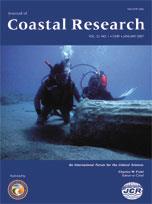Divers in the 1980s discovered a large concentration of archaeological material on the seafloor off Kaulonia, a Greek colony on the Ionian coast of southern Italy. It has been proposed that a small hook-shaped cape, now submerged, was present off the site during settlement from about 700 to 389 BC. Since 1992, however, most of Kaulonia's seafloor sector has been buried by a thick (to 4 m) sand cover. This investigation resumes study of Kaulonia's margin by high-resolution seismic survey, analysis of sediment in cores and excavated sections buried along the coast, and petrologic examination of rock used for construction of a temple, the site's major structure. The sector, located in the tectonically active Calabrian arc, has been subject to considerable elevation rise of land onshore, and an equivalent rate of seafloor subsidence (∼1 mm/yr). A distinct Holocene sequence, composed of beachrock-type sandstone and fluvial-marine–transported conglomerate, in sediment sections landward of the beach can be traced seaward to depths of ∼7 m about 300 m from the present shoreline. Correlation of the sequence helps define changes of coastline position from before Greek settlement to the present. Rather than a generally progressive migration landward of the shoreline in response to relative sea-level rise, the coast has experienced more complex shifts (sea-to-land, land-to-sea, and return to land) due to up-and-down motion in the sector between the alluvial plain behind the beach and innermost shelf. By the mid-Holocene, the shoreline had advanced seaward, resulting in coastal emergence, and it did not return landward (resubmerging the margin) until after the site's abandonment; submergence was complete by late Roman time. We now recognize a broad arcuate headland, rather than a small hooked cape, seaward of the site ∼2500 years ago. Without a lagoon, sufficiently deep lake, or man-made port available for protected anchorage, vessels sailing to Kaulonia for trade were either beached or anchored close to shore and, perhaps seasonally, within the mouth of the Assi River. Composition of beachrock-type sandstone in Holocene sections on land is comparable to that offshore and also to sandstone used for temple base construction. Extensive sandstone exposures along this coast may have been one reason why Greeks selected the site for settlement.
How to translate text using browser tools
1 January 2007
Coast of Ancient Kaulonia (Calabria, Italy): Its Submergence, Lateral Shifts, and Use as a Major Source of Construction Material
Jean-Daniel Stanley,
Maria Pia Bernasconi,
Tamas Toth,
Stefano Mariottini,
Maria Teresa Iannelli
ACCESS THE FULL ARTICLE

Journal of Coastal Research
Vol. 2007 • No. 231
January 2007
Vol. 2007 • No. 231
January 2007
Archaeological material
beach processes
Beachrock
building material
coastline shift
cores
faulting




